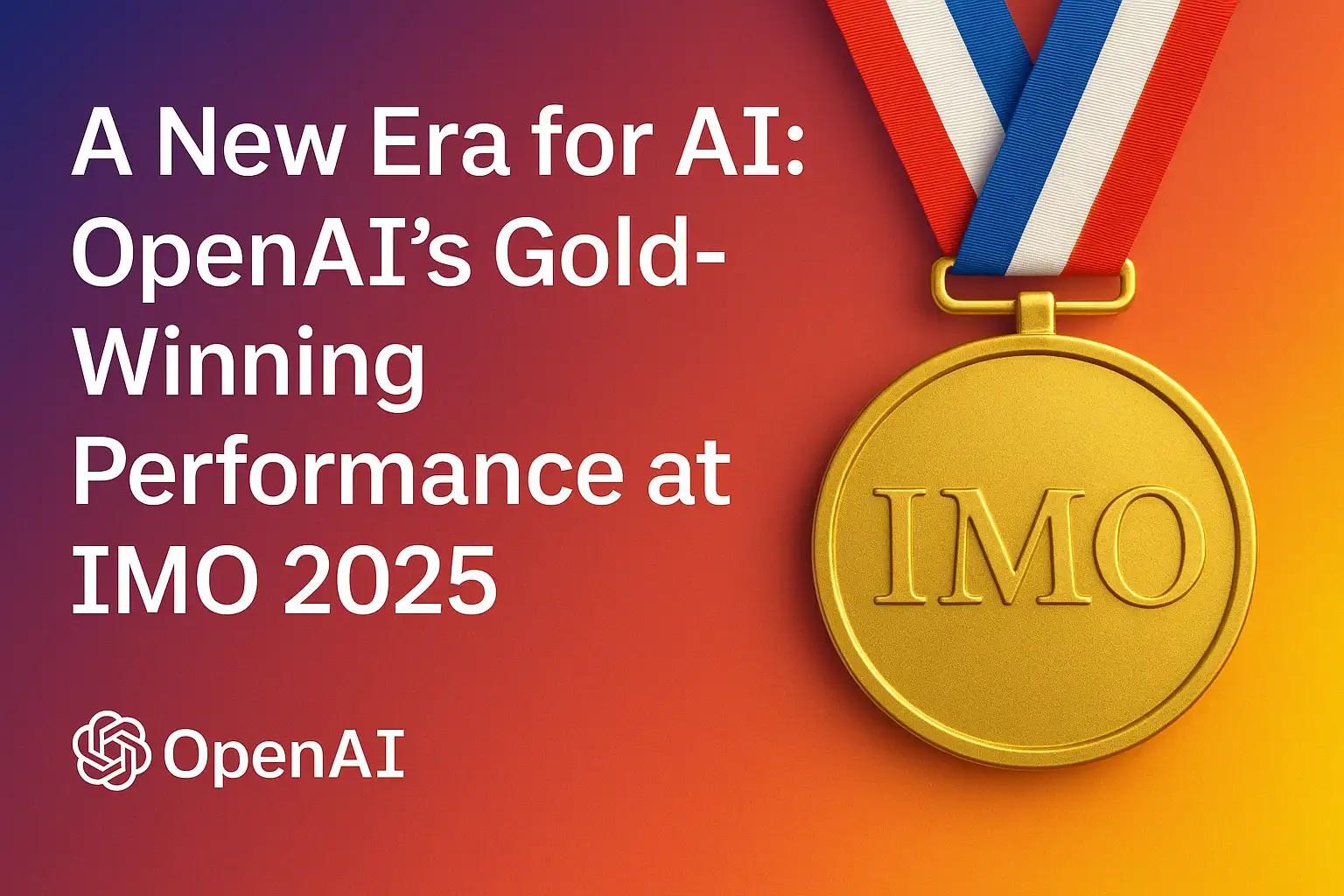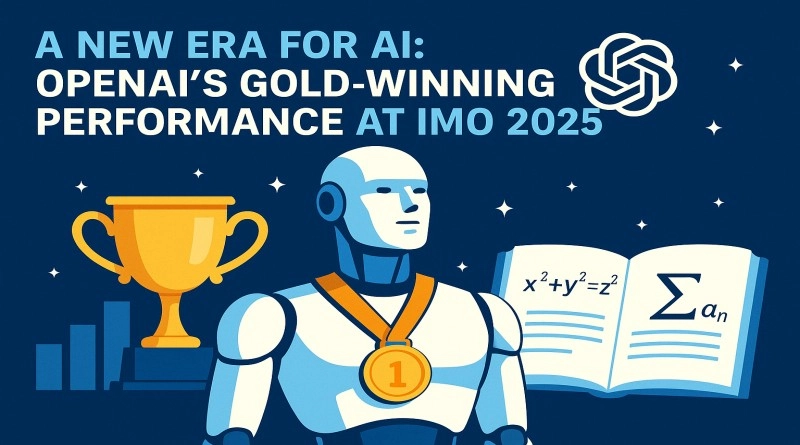A New Era for AI: OpenAI’s Gold-Winning Performance at IMO 2025
Introduction
The world of artificial intelligence (AI) has witnessed a groundbreaking milestone with OpenAI’s experimental reasoning model achieving gold medal-level performance at the 2025 International Mathematical Olympiad (IMO). This prestigious competition, renowned for its rigorous mathematical challenges, has long been a benchmark for human intellect. For an AI to excel at this level marks a significant leap toward general intelligence, sparking excitement and debate about the future of AI-driven problem-solving. In this article, we explore the implications of OpenAI’s achievement, its unique approach, and what it means for the global AI landscape, with insights tailored to resonate with readers in India and beyond.
The International Mathematical Olympiad: A Gold Standard
The IMO, which started in Romania in 1959, is the most important math competition for high school students in the world. Every year, it brings together the smartest young people from more than 100 nations to work on six difficult topics in two 4.5-hour sessions. These topics, which include algebra, geometry, number theory, and combinatorics, need ingenuity, profound reasoning, and careful proof construction—skills that were once regarded to be only human. The competition took place on Australia’s Sunshine Coast in 2025, and just 67 of the 630 contestants (about 11%) won gold medals. This shows how hard it was.
India has a long and proud history with the IMO, always being one of the best countries. The Indian team won six medals in 2025, which put them in seventh place in the world. This background makes OpenAI’s success especially interesting for Indian readers because it shows that AI is now on par with the best math students in the country.
OpenAI’s Breakthrough: A Gold Medal Performance
On July 19, 2025, OpenAI stated that its reasoning model in an experimental mode solved five of the six IMO problems, with a score of 35/42 (sufficient to earn a gold medal). However, in contrast with all other AI systems up to that point, which had limitations of either relying on in-depth tools or taking plenty of think time, the OpenAI model was allowed the same strictures on the human subjects: No internet, no external tools, and only 4.5 hours of total think time per sitting. The model produced natural language proofs that succeeded in creating multi-page arguments that proved themselves to be credible since each one was graded by three former IMO medalists separately.
The uniqueness of this accomplishment is the fact that the model is based on general-purpose reasoning and not on task-specific algorithms. OpenAI scientist Alexander Wei stressed that the model was successful due to breakthroughs in reinforcement learning and test-time compute scaling, along with its achievements in other fields, such as providing a possible argument that is not only innovative but also formulates the “watertight” arguments on the level of human mathematicians. It is different from previous AI models such as NNA glucose prediction and Google DeepMind AlphaGeometry 2, which was much more successful in the field of geometry but did not feature the same depth of logic.
Unique Insights: Beyond the Medal
A Leap Toward General Intelligence
The fact that OpenAI finally managed to work out a math problem is not a big deal alone; it represents a step toward an artificial general intelligence (AGI) system that will be able to do anything that an ordinary human can do intellectually. In comparison to narrow AI designed to drive success in a special domain (e.g., image recognition), the model used by OpenAI is implemented in a broader, human-like reasoning approach to various mathematical tasks. This, according to Sam Altman, the CEO at OpenAI, is a “big milestone” in the world of AI because it was a vision when this company was established.
What this means to India, a country with a rapidly developing tech sector where STEM subjects are taught vehemently, is both an opening and a threat. Researchers and Indian startups can take advantage of the same and come up with local solutions, e.g., improving agricultural yield prediction, better cybersecurity with the use of cutting-edge cryptographic algorithms, etc.

The Indian Context: Opportunities and Challenges
The AI business in India is very dynamic, and by 2030, India is bound to be a global center of AI due to activities such as the India AI Mission. The success of IMO by OpenAI may encourage Indian institutions to incorporate the highest levels of AI into education and research. AI models that will be able to check mathematical proofs may help students studying for such competitive exams as JEE or olympiads offload the teaching staff and make the learning process more efficient.
There are still setbacks, though. This places discrepancies on accessibility, given that training such models runs quite expensively, to the extent that it can cost over 20 dollars per solution in certain instances. These costs were to be faced by Indian researchers qualified to work in the field of AI to promote ethical development as competition with other countries increases. Besides, the so-called jagged intelligence effect, when the AI is talented at the complex tasks but fails at the simple ones (such as a comparison of 9.11 or 9.9), suggests the necessity of strong and comprehensive systems.
Controversy and Skepticism
The announcement by OpenAI was controversial because it had been published prematurely, in breach of an IMO embargo asking the AI software providers not to publish the results until July 28. This decision was criticized by the IMO community and Google DeepMind, its competitor, since it followed the official procedure as well. Moreover, Gary Marcus, a critic of AI, mentioned that the results of OpenAI will be independently verified by IMO organizers, which casts doubts about transparency.
The issue also highlights that ethics are important in AI research, and this lesson will also be applicable in the case of AI researcher communities in India as the country continues to develop trust in its advances. Open validation points to strategic credibility postulations in international competitions.
The Broader Impact: AI in Mathematics and Beyond
The success of OpenAI means the possibility of the future in which AI can cooperate with mathematicians and solve unsolved problems, like those in cryptography or theoretical physics. The U.S. Defense Advanced Research Projects Agency (DARPA) recently began a research program that is investigating AI as a so-called co-author of high-level mathematics research in an attempt to speed scientific discovery.
India is also home to many industries based on math, such as software development and data science, so such AI breakthroughs may revolutionize the industry. As an example, proof verification via AI would make research more efficient in places such as the Indian Institute of Science (IISc) or the IITs, and they could then become innovative in such a new field as quantum computing.
Looking Ahead: What’s Next for AI?
OpenAI has made it clear that the gold medal-winning model is an experimental project, and it will not become publicly available any time soon. In the meantime, Google DeepMind has rolled out its own gem in the Gemini Deep Think to trusted testers, such as mathematicians, and intends to offer wider availability through Google AI Ultra subscriptions. Such a two-part advancement of OpenAI and Google highlights how fast the development of AI can be as the two companies expand the limits of reasoning ability.
To Indian readers, this is a wake-up call. Educators, policymakers, and students need to adopt AI as the tool of learning and research and cope with ethical and accessibility issues. The AI technology may transform India in the greater tech scenario as it acquires the capacity to solve complicated issues.
Conclusion
The gold medal performance of OpenAI at the upcoming IMO 2025 is far more than a technological breakthrough; it is a first step toward an AI-enhanced human ingenuity. OpenAI has lived up to the hype and captured the world with its ability to solve some of its most difficult math problems in a general-purpose manner, both with awe and trepidation in mind. To the Indian scenario, it is a clear indication that the country can still use AI in education, use it in research, and utilize it in innovation, so long as it approaches the issues involved with forethought and ethics. Since we are at the dawn of a new age in AI, the question is not only about what AI can do, but what can we do responsibly in order to ensure our world is positively affected by AI?
Disclaimer
The information presented in this blog is derived from publicly available sources for general use, including any cited references. While we strive to mention credible sources whenever possible,
Web Techneeq – Web Design Agency in Mumbai does not guarantee the accuracy of the information provided in any way. This article is intended solely for general informational purposes. It should be understood that it does not constitute legal advice and does not aim to serve as such. If any individual(s) make decisions based on the information in this article without verifying the facts, we explicitly reject any liability that may arise as a result. We recommend that readers seek separate guidance regarding any specific information provided here.

